Literature Review: Technology and Innovation in Strategic Management
VerifiedAdded on 2022/10/14
|27
|5693
|18
Report
AI Summary
This report presents a systematic literature review on the impact of technology and innovation on strategic management within organizations. It examines various articles, including those focusing on responsible innovation, marketing innovation in the context of Industry 4.0, and the integration of supply chains for enhanced competitiveness and firm performance. The review analyzes the strategic implications of these innovations, offering recommendations for firms to improve and maintain their competitive edge. Key areas of discussion include organizational commitment to innovation, the role of marketing innovation, and the importance of process innovation in SMEs. The report also touches on the evolution of marketing innovation and its impact on business strategies. It draws conclusions from data analysis and surveys, emphasizing the importance of strong organizational commitment and the benefits of process innovation in driving product innovation and overall business performance. The report also addresses the evolution of marketing innovations and how organizations can adopt a strategic approach.
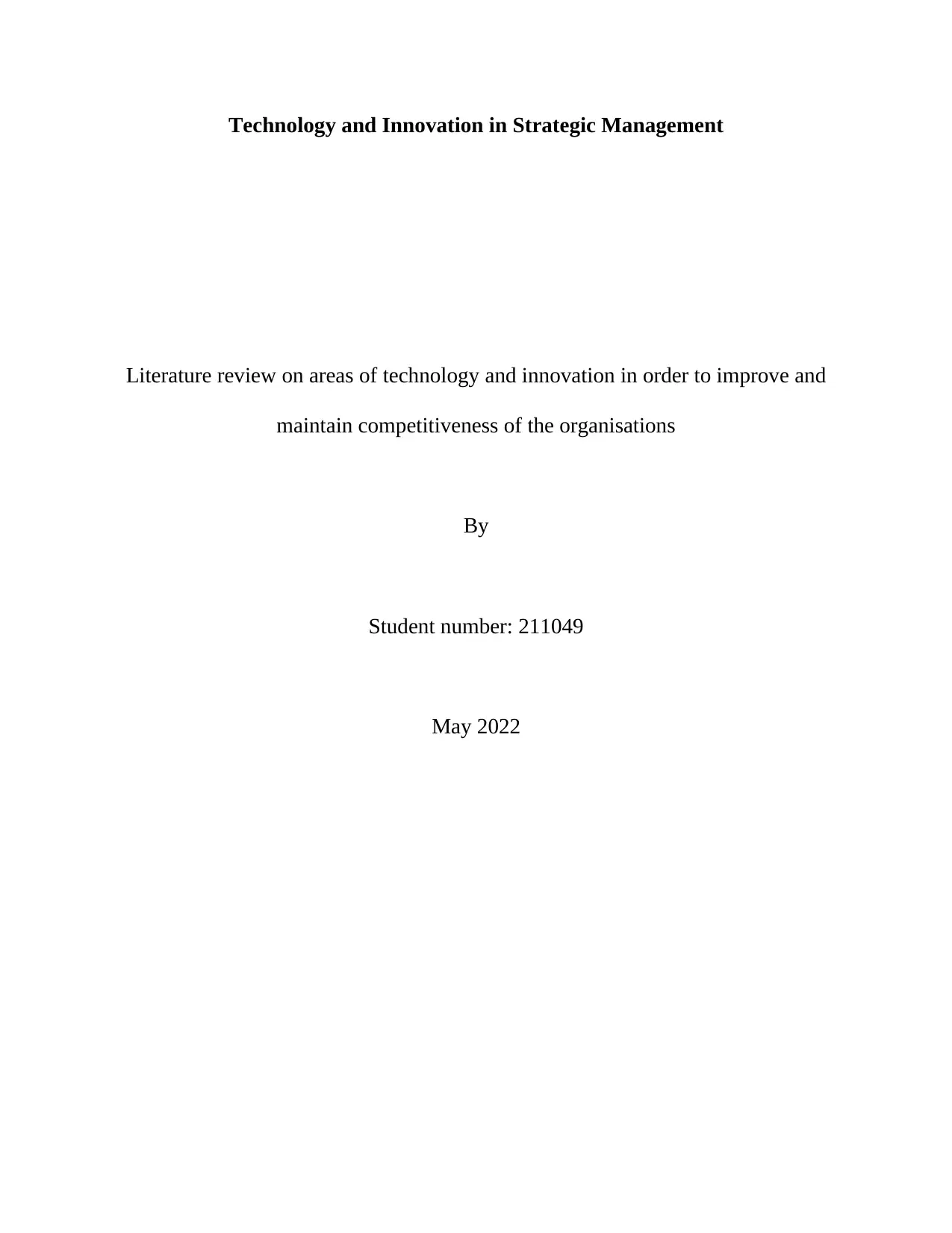
Technology and Innovation in Strategic Management
Literature review on areas of technology and innovation in order to improve and
maintain competitiveness of the organisations
By
Student number: 211049
May 2022
Literature review on areas of technology and innovation in order to improve and
maintain competitiveness of the organisations
By
Student number: 211049
May 2022
Paraphrase This Document
Need a fresh take? Get an instant paraphrase of this document with our AI Paraphraser
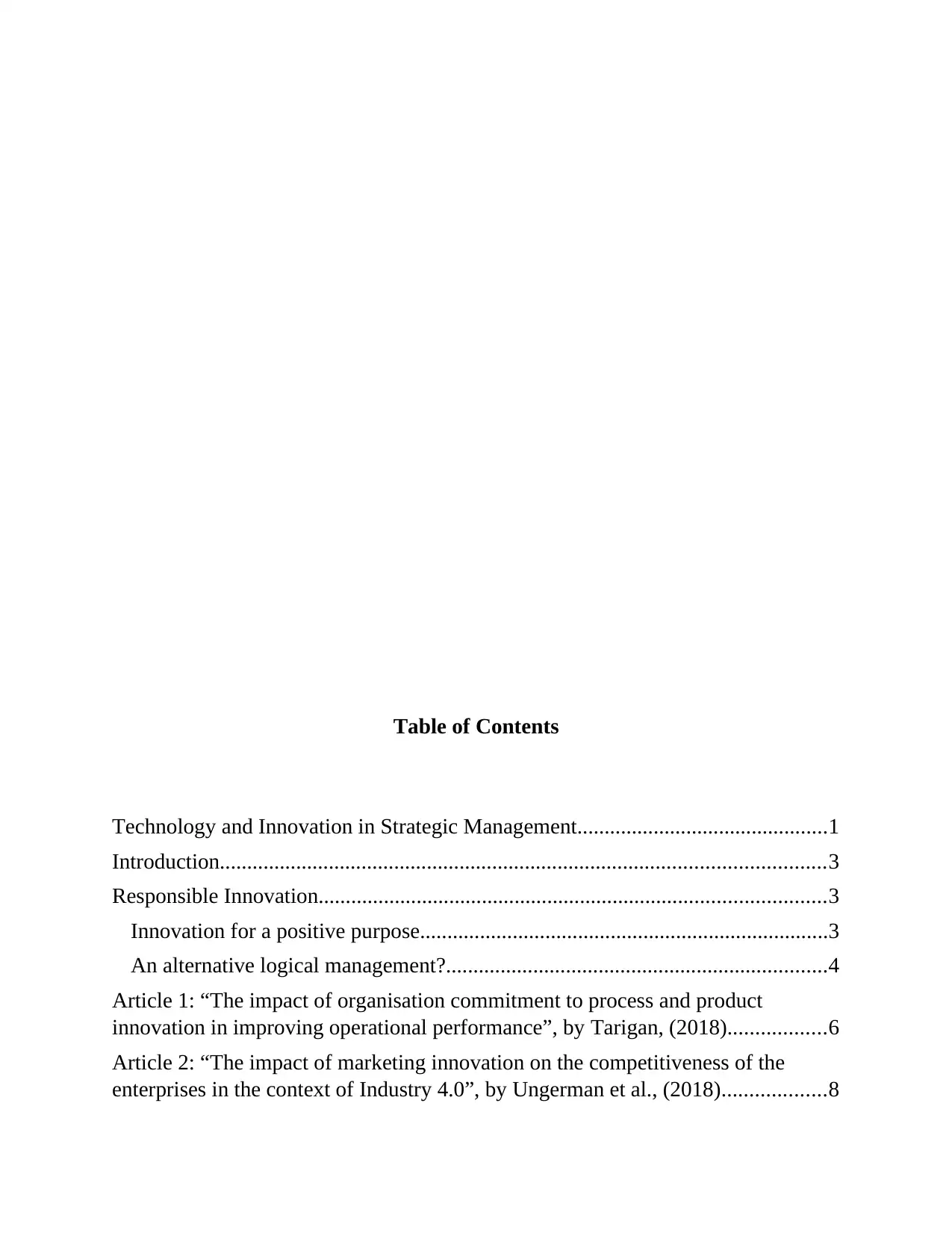
Table of Contents
Technology and Innovation in Strategic Management..............................................1
Introduction...............................................................................................................3
Responsible Innovation.............................................................................................3
Innovation for a positive purpose...........................................................................3
An alternative logical management?......................................................................4
Article 1: “The impact of organisation commitment to process and product
innovation in improving operational performance”, by Tarigan, (2018)..................6
Article 2: “The impact of marketing innovation on the competitiveness of the
enterprises in the context of Industry 4.0”, by Ungerman et al., (2018)...................8
Technology and Innovation in Strategic Management..............................................1
Introduction...............................................................................................................3
Responsible Innovation.............................................................................................3
Innovation for a positive purpose...........................................................................3
An alternative logical management?......................................................................4
Article 1: “The impact of organisation commitment to process and product
innovation in improving operational performance”, by Tarigan, (2018)..................6
Article 2: “The impact of marketing innovation on the competitiveness of the
enterprises in the context of Industry 4.0”, by Ungerman et al., (2018)...................8

Article: 3 “Innovation-oriented supply chain integration for combined
competitiveness and firm performance”by Lii and Kuo, (2016).............................10
Recommendations...................................................................................................13
References...............................................................................................................17
competitiveness and firm performance”by Lii and Kuo, (2016).............................10
Recommendations...................................................................................................13
References...............................................................................................................17
⊘ This is a preview!⊘
Do you want full access?
Subscribe today to unlock all pages.

Trusted by 1+ million students worldwide
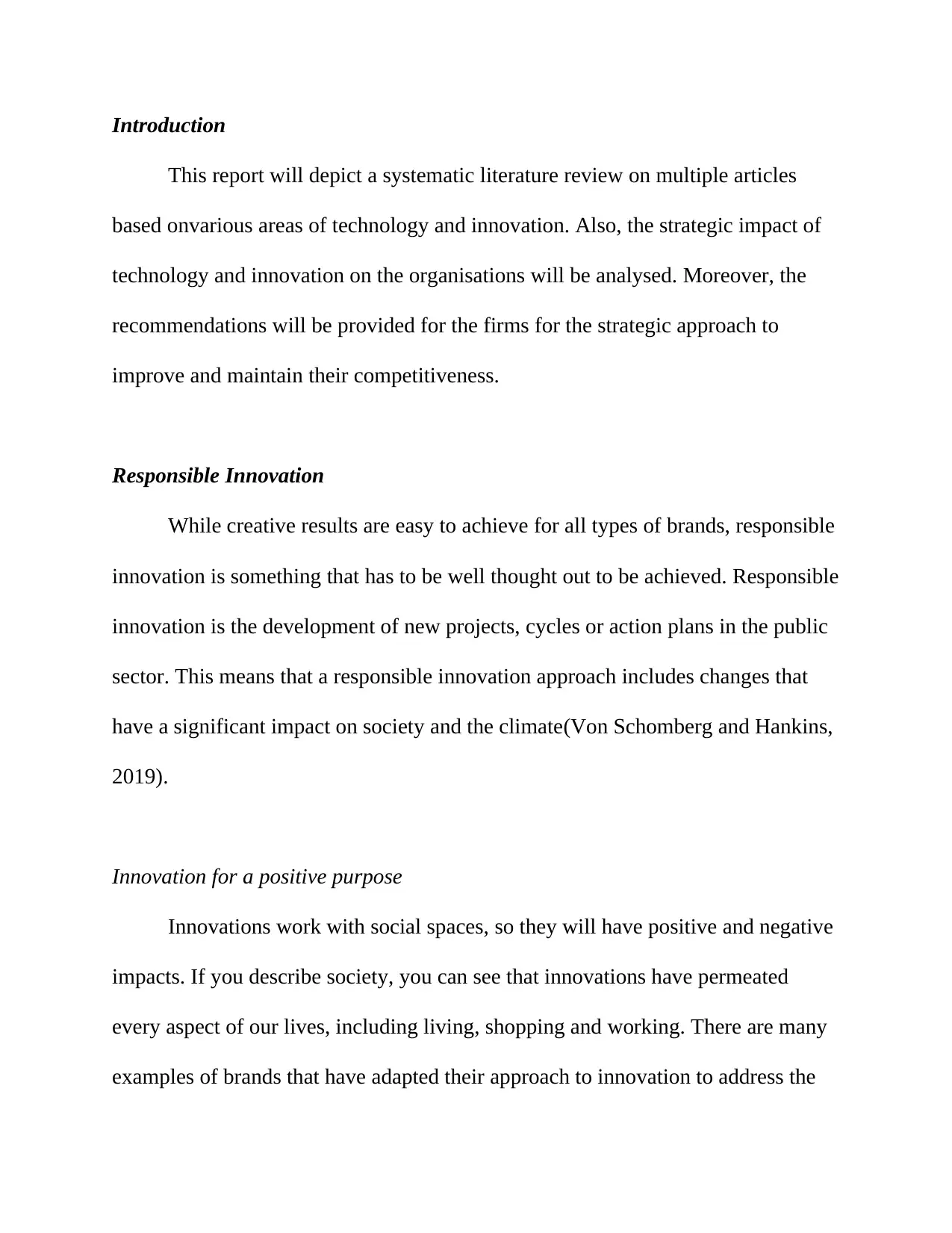
Introduction
This report will depict a systematic literature review on multiple articles
based onvarious areas of technology and innovation. Also, the strategic impact of
technology and innovation on the organisations will be analysed. Moreover, the
recommendations will be provided for the firms for the strategic approach to
improve and maintain their competitiveness.
Responsible Innovation
While creative results are easy to achieve for all types of brands, responsible
innovation is something that has to be well thought out to be achieved. Responsible
innovation is the development of new projects, cycles or action plans in the public
sector. This means that a responsible innovation approach includes changes that
have a significant impact on society and the climate(Von Schomberg and Hankins,
2019).
Innovation for a positive purpose
Innovations work with social spaces, so they will have positive and negative
impacts. If you describe society, you can see that innovations have permeated
every aspect of our lives, including living, shopping and working. There are many
examples of brands that have adapted their approach to innovation to address the
This report will depict a systematic literature review on multiple articles
based onvarious areas of technology and innovation. Also, the strategic impact of
technology and innovation on the organisations will be analysed. Moreover, the
recommendations will be provided for the firms for the strategic approach to
improve and maintain their competitiveness.
Responsible Innovation
While creative results are easy to achieve for all types of brands, responsible
innovation is something that has to be well thought out to be achieved. Responsible
innovation is the development of new projects, cycles or action plans in the public
sector. This means that a responsible innovation approach includes changes that
have a significant impact on society and the climate(Von Schomberg and Hankins,
2019).
Innovation for a positive purpose
Innovations work with social spaces, so they will have positive and negative
impacts. If you describe society, you can see that innovations have permeated
every aspect of our lives, including living, shopping and working. There are many
examples of brands that have adapted their approach to innovation to address the
Paraphrase This Document
Need a fresh take? Get an instant paraphrase of this document with our AI Paraphraser

difficulties associated with these social spaces. It is clear that one of the major
social problems prevalent in non-industrialised countries is the expressed need for
unhappy everyday conditions and access to few goods. The tendency to shy away
from social issues such as these has led to negative reactions from brands such as
Primark and Misguided, which have recently been confronted with ignorant
analyses of the environments in which representatives in less developed countries
operate(Mastenbroek et al., 2021).
Despite this, some brands have taken an alternative stance to help address
social issues in a positive and innovative way. Toms, a California-based footwear
brand, has chosen to radicalise its action plan to focus on its One for One brand
idea. To summarise the brand's model: For every pair of shoes purchased from
Toms, the brand donates shoes to young people with limited resources. With their
responsible and resourceful action plan, their organiser Ben Mycoskie is leading
the charge to ensure that their customers' social concerns are addressed by
empowering them to combat social issues with their purchases(Van der Burg et al.,
2019). This highlights the importance of responsible innovation, as Tom's action
plan demonstrates that brands in developed countries can use their assets and the
support of their customers to make a positive impact in less developed countries.
An alternative logical management?
social problems prevalent in non-industrialised countries is the expressed need for
unhappy everyday conditions and access to few goods. The tendency to shy away
from social issues such as these has led to negative reactions from brands such as
Primark and Misguided, which have recently been confronted with ignorant
analyses of the environments in which representatives in less developed countries
operate(Mastenbroek et al., 2021).
Despite this, some brands have taken an alternative stance to help address
social issues in a positive and innovative way. Toms, a California-based footwear
brand, has chosen to radicalise its action plan to focus on its One for One brand
idea. To summarise the brand's model: For every pair of shoes purchased from
Toms, the brand donates shoes to young people with limited resources. With their
responsible and resourceful action plan, their organiser Ben Mycoskie is leading
the charge to ensure that their customers' social concerns are addressed by
empowering them to combat social issues with their purchases(Van der Burg et al.,
2019). This highlights the importance of responsible innovation, as Tom's action
plan demonstrates that brands in developed countries can use their assets and the
support of their customers to make a positive impact in less developed countries.
An alternative logical management?
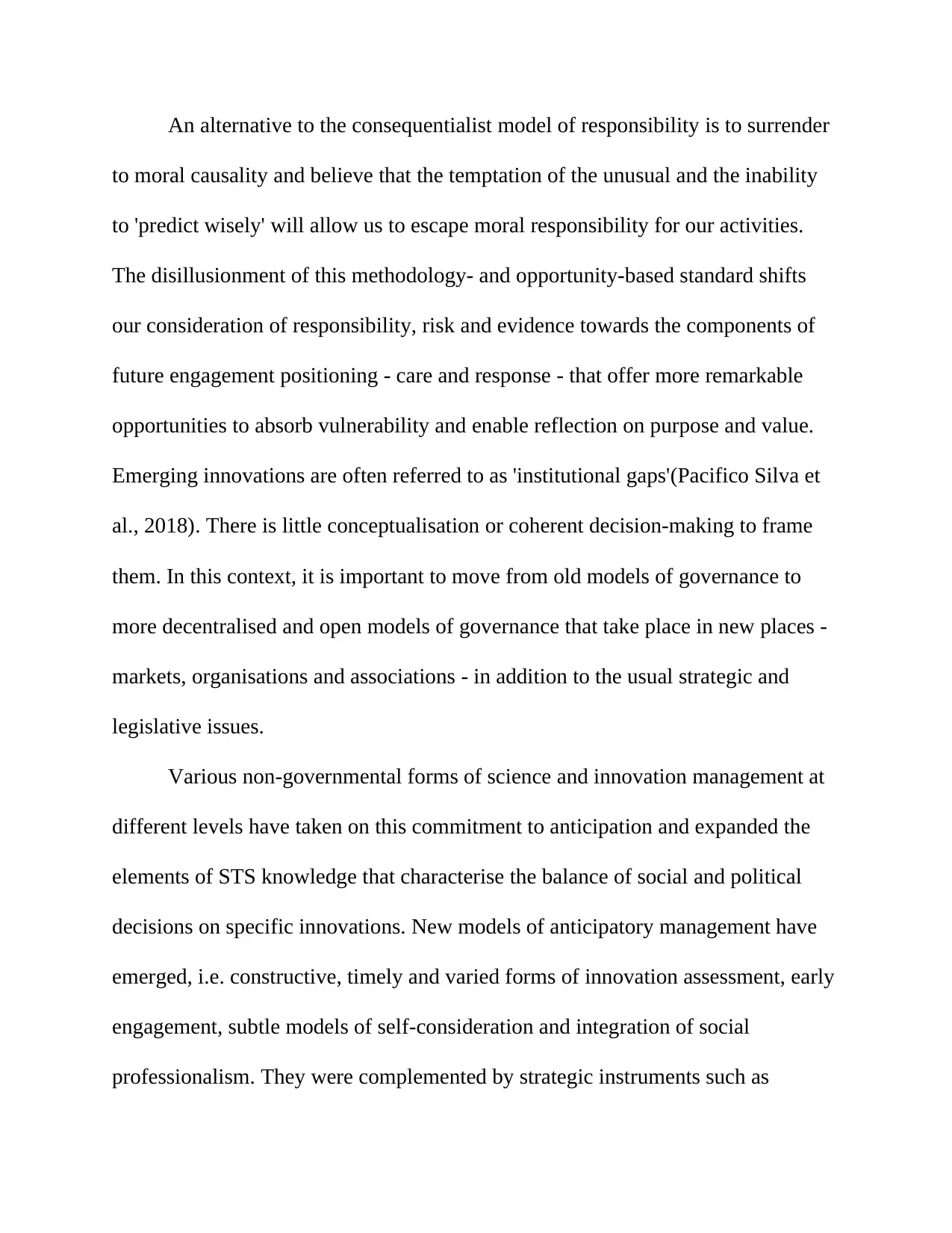
An alternative to the consequentialist model of responsibility is to surrender
to moral causality and believe that the temptation of the unusual and the inability
to 'predict wisely' will allow us to escape moral responsibility for our activities.
The disillusionment of this methodology- and opportunity-based standard shifts
our consideration of responsibility, risk and evidence towards the components of
future engagement positioning - care and response - that offer more remarkable
opportunities to absorb vulnerability and enable reflection on purpose and value.
Emerging innovations are often referred to as 'institutional gaps'(Pacifico Silva et
al., 2018). There is little conceptualisation or coherent decision-making to frame
them. In this context, it is important to move from old models of governance to
more decentralised and open models of governance that take place in new places -
markets, organisations and associations - in addition to the usual strategic and
legislative issues.
Various non-governmental forms of science and innovation management at
different levels have taken on this commitment to anticipation and expanded the
elements of STS knowledge that characterise the balance of social and political
decisions on specific innovations. New models of anticipatory management have
emerged, i.e. constructive, timely and varied forms of innovation assessment, early
engagement, subtle models of self-consideration and integration of social
professionalism. They were complemented by strategic instruments such as
to moral causality and believe that the temptation of the unusual and the inability
to 'predict wisely' will allow us to escape moral responsibility for our activities.
The disillusionment of this methodology- and opportunity-based standard shifts
our consideration of responsibility, risk and evidence towards the components of
future engagement positioning - care and response - that offer more remarkable
opportunities to absorb vulnerability and enable reflection on purpose and value.
Emerging innovations are often referred to as 'institutional gaps'(Pacifico Silva et
al., 2018). There is little conceptualisation or coherent decision-making to frame
them. In this context, it is important to move from old models of governance to
more decentralised and open models of governance that take place in new places -
markets, organisations and associations - in addition to the usual strategic and
legislative issues.
Various non-governmental forms of science and innovation management at
different levels have taken on this commitment to anticipation and expanded the
elements of STS knowledge that characterise the balance of social and political
decisions on specific innovations. New models of anticipatory management have
emerged, i.e. constructive, timely and varied forms of innovation assessment, early
engagement, subtle models of self-consideration and integration of social
professionalism. They were complemented by strategic instruments such as
⊘ This is a preview!⊘
Do you want full access?
Subscribe today to unlock all pages.

Trusted by 1+ million students worldwide
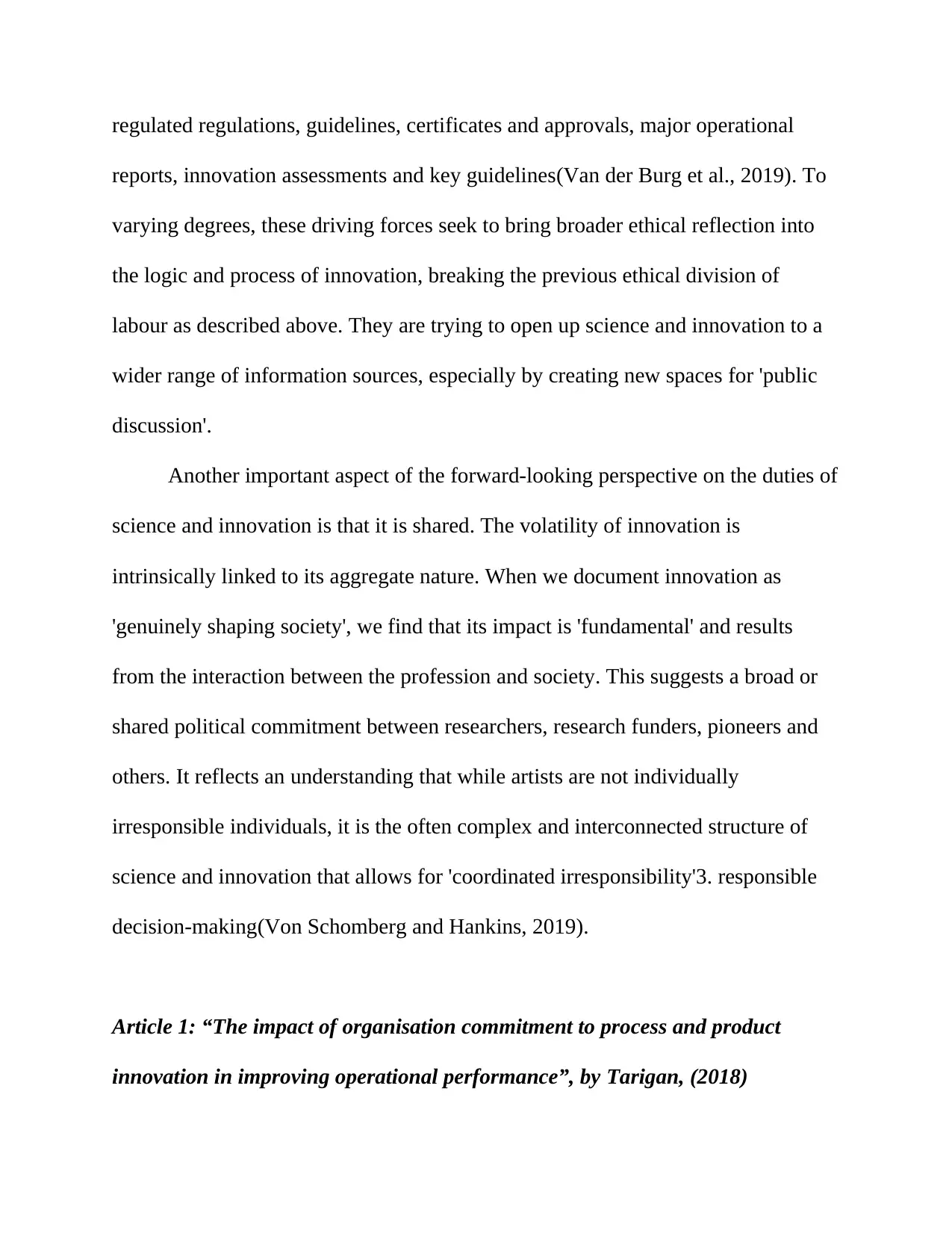
regulated regulations, guidelines, certificates and approvals, major operational
reports, innovation assessments and key guidelines(Van der Burg et al., 2019). To
varying degrees, these driving forces seek to bring broader ethical reflection into
the logic and process of innovation, breaking the previous ethical division of
labour as described above. They are trying to open up science and innovation to a
wider range of information sources, especially by creating new spaces for 'public
discussion'.
Another important aspect of the forward-looking perspective on the duties of
science and innovation is that it is shared. The volatility of innovation is
intrinsically linked to its aggregate nature. When we document innovation as
'genuinely shaping society', we find that its impact is 'fundamental' and results
from the interaction between the profession and society. This suggests a broad or
shared political commitment between researchers, research funders, pioneers and
others. It reflects an understanding that while artists are not individually
irresponsible individuals, it is the often complex and interconnected structure of
science and innovation that allows for 'coordinated irresponsibility'3. responsible
decision-making(Von Schomberg and Hankins, 2019).
Article 1: “The impact of organisation commitment to process and product
innovation in improving operational performance”, by Tarigan, (2018)
reports, innovation assessments and key guidelines(Van der Burg et al., 2019). To
varying degrees, these driving forces seek to bring broader ethical reflection into
the logic and process of innovation, breaking the previous ethical division of
labour as described above. They are trying to open up science and innovation to a
wider range of information sources, especially by creating new spaces for 'public
discussion'.
Another important aspect of the forward-looking perspective on the duties of
science and innovation is that it is shared. The volatility of innovation is
intrinsically linked to its aggregate nature. When we document innovation as
'genuinely shaping society', we find that its impact is 'fundamental' and results
from the interaction between the profession and society. This suggests a broad or
shared political commitment between researchers, research funders, pioneers and
others. It reflects an understanding that while artists are not individually
irresponsible individuals, it is the often complex and interconnected structure of
science and innovation that allows for 'coordinated irresponsibility'3. responsible
decision-making(Von Schomberg and Hankins, 2019).
Article 1: “The impact of organisation commitment to process and product
innovation in improving operational performance”, by Tarigan, (2018)
Paraphrase This Document
Need a fresh take? Get an instant paraphrase of this document with our AI Paraphraser
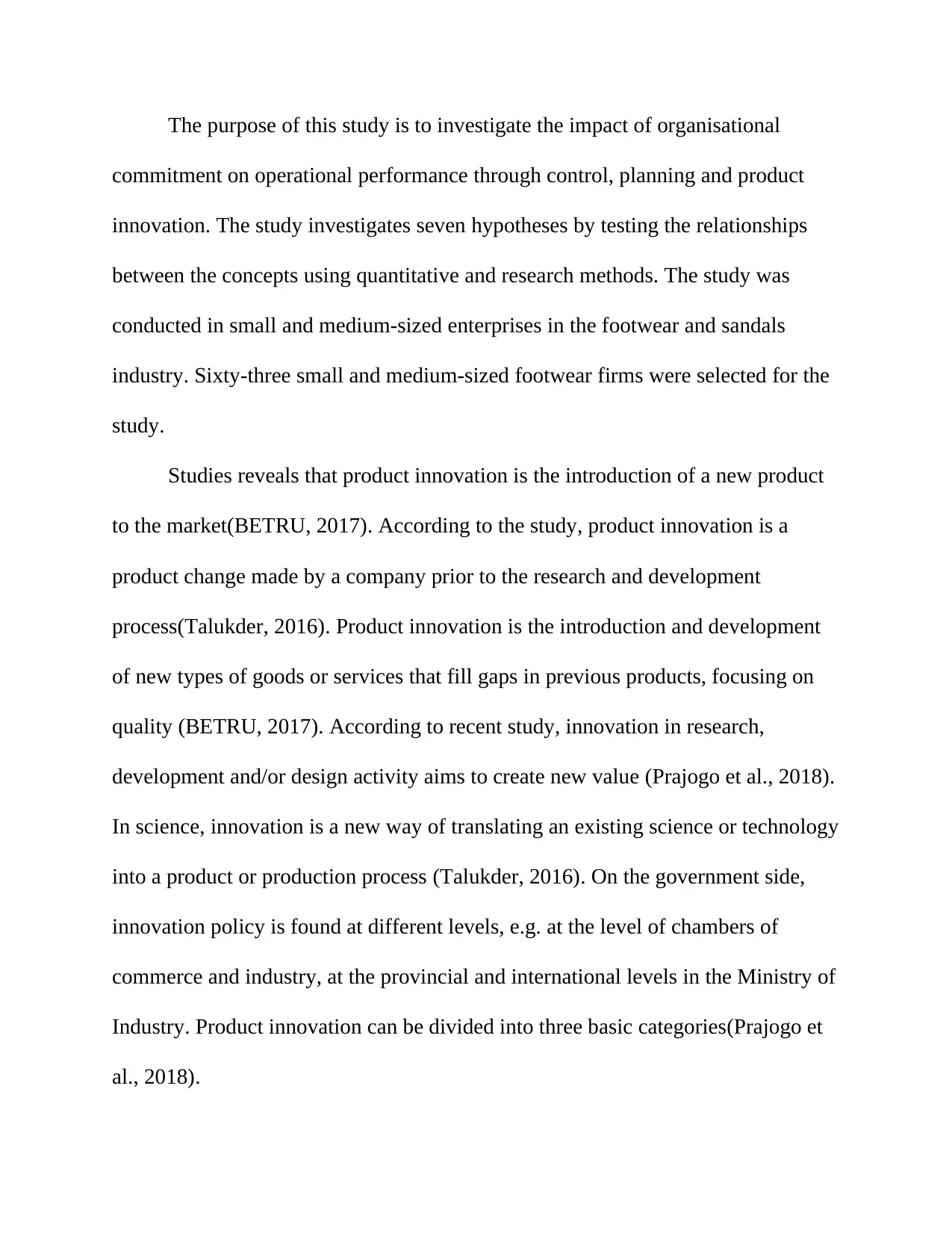
The purpose of this study is to investigate the impact of organisational
commitment on operational performance through control, planning and product
innovation. The study investigates seven hypotheses by testing the relationships
between the concepts using quantitative and research methods. The study was
conducted in small and medium-sized enterprises in the footwear and sandals
industry. Sixty-three small and medium-sized footwear firms were selected for the
study.
Studies reveals that product innovation is the introduction of a new product
to the market(BETRU, 2017). According to the study, product innovation is a
product change made by a company prior to the research and development
process(Talukder, 2016). Product innovation is the introduction and development
of new types of goods or services that fill gaps in previous products, focusing on
quality (BETRU, 2017). According to recent study, innovation in research,
development and/or design activity aims to create new value (Prajogo et al., 2018).
In science, innovation is a new way of translating an existing science or technology
into a product or production process (Talukder, 2016). On the government side,
innovation policy is found at different levels, e.g. at the level of chambers of
commerce and industry, at the provincial and international levels in the Ministry of
Industry. Product innovation can be divided into three basic categories(Prajogo et
al., 2018).
commitment on operational performance through control, planning and product
innovation. The study investigates seven hypotheses by testing the relationships
between the concepts using quantitative and research methods. The study was
conducted in small and medium-sized enterprises in the footwear and sandals
industry. Sixty-three small and medium-sized footwear firms were selected for the
study.
Studies reveals that product innovation is the introduction of a new product
to the market(BETRU, 2017). According to the study, product innovation is a
product change made by a company prior to the research and development
process(Talukder, 2016). Product innovation is the introduction and development
of new types of goods or services that fill gaps in previous products, focusing on
quality (BETRU, 2017). According to recent study, innovation in research,
development and/or design activity aims to create new value (Prajogo et al., 2018).
In science, innovation is a new way of translating an existing science or technology
into a product or production process (Talukder, 2016). On the government side,
innovation policy is found at different levels, e.g. at the level of chambers of
commerce and industry, at the provincial and international levels in the Ministry of
Industry. Product innovation can be divided into three basic categories(Prajogo et
al., 2018).

Product line extensions, compliant products and the emergence of new
products. Product line extensions are relatively new to the market but not to the
company (Talukder, 2016). Conference products are relatively new to the
company, but the products are already known in the market(Prajogo et al., 2018).
Products new to the market are new to the company and the market. Three
indicators can measure product innovation. These include the development of new
products, product quality improvement, and the acceleration of the market launch
of new products (Teh et al., 2015). In addition, design plays an important role in
product innovation because it facilitates product manufacturing and reduces the
number of defective products (BETRU, 2017). Manufacturing processes include
supplying materials, auxiliary materials, packaging materials, semi-finished
products and finished products that can be delivered to customers. Process
innovation describes a change in how a company produces products and services
(Prajogo et al., 2018).
Process innovation introduces the latest production process or a new daily
routine activity. Process innovation is a latest production method in which new
technology is applied to the whole value chain process, including production,
distribution and processing (Teh et al., 2015). Process innovation in SMEs is a
process involving various interactions between stakeholders. Networks,
relationships and social closeness are usually stronger at the local level. This is
products. Product line extensions are relatively new to the market but not to the
company (Talukder, 2016). Conference products are relatively new to the
company, but the products are already known in the market(Prajogo et al., 2018).
Products new to the market are new to the company and the market. Three
indicators can measure product innovation. These include the development of new
products, product quality improvement, and the acceleration of the market launch
of new products (Teh et al., 2015). In addition, design plays an important role in
product innovation because it facilitates product manufacturing and reduces the
number of defective products (BETRU, 2017). Manufacturing processes include
supplying materials, auxiliary materials, packaging materials, semi-finished
products and finished products that can be delivered to customers. Process
innovation describes a change in how a company produces products and services
(Prajogo et al., 2018).
Process innovation introduces the latest production process or a new daily
routine activity. Process innovation is a latest production method in which new
technology is applied to the whole value chain process, including production,
distribution and processing (Teh et al., 2015). Process innovation in SMEs is a
process involving various interactions between stakeholders. Networks,
relationships and social closeness are usually stronger at the local level. This is
⊘ This is a preview!⊘
Do you want full access?
Subscribe today to unlock all pages.

Trusted by 1+ million students worldwide

very essential for developing social relations including, communication, mutual
trust and interaction, and a culture of openness to latest ways of thinking
(Bresnahan and Yin, 2017). Research has shown that process innovation changes
the way products are made and transported (Bresnahan and Yin, 2017). Process
innovation leads companies to adopt new ways of working by acquiring new
technologies or improving existing ones. This helps companies achieve economies
of scale or scope, which improves quality (BETRU, 2017).
Process innovation increases the efficiency of production processes, which
in turn leads to cost reductions. When an organisation grows, the need to change
strategy and structure becomes apparent (Bresnahan and Yin, 2017). Strategic
change is about changing how employees construct meaning by engaging in
discourse that sets a new direction for the company(Prajogo et al., 2018). All
organisations need to adapt their strategies, structures, management processes and
administrative procedures(Talukder, 2016). Many companies take a two-pronged
approach to these changes, aligning the technical and managerial aspects of the
business. The technical side denotes the people who manufacture the products or
services offered by the company.
In contrast, the managerial side guarantees that the company's daily
activities are carried out and that the objectives associated with the company's
activities are achieved(Teh et al., 2015). Even if both sides have completely
trust and interaction, and a culture of openness to latest ways of thinking
(Bresnahan and Yin, 2017). Research has shown that process innovation changes
the way products are made and transported (Bresnahan and Yin, 2017). Process
innovation leads companies to adopt new ways of working by acquiring new
technologies or improving existing ones. This helps companies achieve economies
of scale or scope, which improves quality (BETRU, 2017).
Process innovation increases the efficiency of production processes, which
in turn leads to cost reductions. When an organisation grows, the need to change
strategy and structure becomes apparent (Bresnahan and Yin, 2017). Strategic
change is about changing how employees construct meaning by engaging in
discourse that sets a new direction for the company(Prajogo et al., 2018). All
organisations need to adapt their strategies, structures, management processes and
administrative procedures(Talukder, 2016). Many companies take a two-pronged
approach to these changes, aligning the technical and managerial aspects of the
business. The technical side denotes the people who manufacture the products or
services offered by the company.
In contrast, the managerial side guarantees that the company's daily
activities are carried out and that the objectives associated with the company's
activities are achieved(Teh et al., 2015). Even if both sides have completely
Paraphrase This Document
Need a fresh take? Get an instant paraphrase of this document with our AI Paraphraser

different ideas about what needs to be changed, they must align perfectly and work
towards the same goal. For example, the costs of customer complaints and returns
are reduced(Talukder, 2016).
Therefore, it is essential to continuously make improvements. The
improvement process can be measured in three ways: continuous improvement of
the production process, dissemination of exploratory data, and repeated training in
production-related areas. Several conclusions can be drawn from the data analysis
and surveys(Prajogo et al., 2018). First, a strong organisational commitment
ensures excellence in innovation processes through established guidelines and
procedures with clearly defined competencies and responsibilities(Bresnahan and
Yin, 2017). Furthermore, process innovation in SMEs contributes to product
innovation and improves overall business performance(Talukder, 2016).
Article 2: “The impact of marketing innovation on the competitiveness of the
enterprises in the context of Industry 4.0”, by Ungerman et al., (2018)
The main objective of this article is to analyse and identify the impact of
innovation marketing on the competitiveness of companies in the context of
Industry 4.0. To accomplish this goal, it is essential to create a quality database that
is large enough to analyse this topic in all its complexity. The outcome of the entire
study depends mainly on the quality of the database. The pilot survey was
towards the same goal. For example, the costs of customer complaints and returns
are reduced(Talukder, 2016).
Therefore, it is essential to continuously make improvements. The
improvement process can be measured in three ways: continuous improvement of
the production process, dissemination of exploratory data, and repeated training in
production-related areas. Several conclusions can be drawn from the data analysis
and surveys(Prajogo et al., 2018). First, a strong organisational commitment
ensures excellence in innovation processes through established guidelines and
procedures with clearly defined competencies and responsibilities(Bresnahan and
Yin, 2017). Furthermore, process innovation in SMEs contributes to product
innovation and improves overall business performance(Talukder, 2016).
Article 2: “The impact of marketing innovation on the competitiveness of the
enterprises in the context of Industry 4.0”, by Ungerman et al., (2018)
The main objective of this article is to analyse and identify the impact of
innovation marketing on the competitiveness of companies in the context of
Industry 4.0. To accomplish this goal, it is essential to create a quality database that
is large enough to analyse this topic in all its complexity. The outcome of the entire
study depends mainly on the quality of the database. The pilot survey was

conducted to obtain a basic orientation on the problem at hand and to obtain basic
statistical characteristics for the subsequent selection of appropriate data
processing methods and procedures.
In accordance with the recent researches marketing innovation should
involve marketing concepts and strategies that differ significantly from the original
marketing approach(Colbert et al., 2016). Marketing innovation is based on the
realisation that simply following existing marketing principles does not guarantee
performance and competitiveness in a crowded market. Marketing innovation is
based on lateral thinking whose bold, borderless and provocative(Attaran et al.,
2019). The fields of marketing innovation are gradually evolving. They include
personal marketing, ambient marketing, ambushmarketing, guerrilla marketing,
viral marketing, buzzmarketing, mobilemarketing, product placement all-case
marketing, word-of-mouth marketing, geo-marketing,neuro-marketing behavioural
marketing, etc. (Colbert et al., 2016). These new areas are emerging very
rapidly(Colbert et al., 2016). These new areas are emerging very quickly, and their
significant impact on the market. These new areas are evolving quickly, and their
definitions and classifications are often inconsistent. Many studies have classified
innovative marketing into six major regions(Smith et al., 2019).
The first is an innovation based on key technology - the use of key
technologies has led to new and different products. The second is an innovation
statistical characteristics for the subsequent selection of appropriate data
processing methods and procedures.
In accordance with the recent researches marketing innovation should
involve marketing concepts and strategies that differ significantly from the original
marketing approach(Colbert et al., 2016). Marketing innovation is based on the
realisation that simply following existing marketing principles does not guarantee
performance and competitiveness in a crowded market. Marketing innovation is
based on lateral thinking whose bold, borderless and provocative(Attaran et al.,
2019). The fields of marketing innovation are gradually evolving. They include
personal marketing, ambient marketing, ambushmarketing, guerrilla marketing,
viral marketing, buzzmarketing, mobilemarketing, product placement all-case
marketing, word-of-mouth marketing, geo-marketing,neuro-marketing behavioural
marketing, etc. (Colbert et al., 2016). These new areas are emerging very
rapidly(Colbert et al., 2016). These new areas are emerging very quickly, and their
significant impact on the market. These new areas are evolving quickly, and their
definitions and classifications are often inconsistent. Many studies have classified
innovative marketing into six major regions(Smith et al., 2019).
The first is an innovation based on key technology - the use of key
technologies has led to new and different products. The second is an innovation
⊘ This is a preview!⊘
Do you want full access?
Subscribe today to unlock all pages.

Trusted by 1+ million students worldwide
1 out of 27
Related Documents
Your All-in-One AI-Powered Toolkit for Academic Success.
+13062052269
info@desklib.com
Available 24*7 on WhatsApp / Email
![[object Object]](/_next/static/media/star-bottom.7253800d.svg)
Unlock your academic potential
Copyright © 2020–2025 A2Z Services. All Rights Reserved. Developed and managed by ZUCOL.





